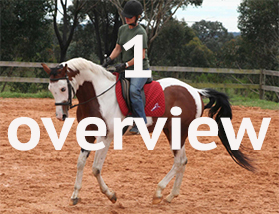
Canter - Overview
Canter can often be difficult for riders to get established.
This series looks at the most common obstacles and how to deal with them.
Training Information
Suitable for: All horses
Videos in course: 6
This series teaches you how to establish the canter or retrain a horse that has problems with the canter.
Purpose
The purpose of this course is to get your horse cantering - every time you cue, in a relaxed and soft frame and to continue cantering until cued to do something else.
During this an Australian Stock Horse stallion and a Warmblood gelding will be used as just two of the examples - both starting the canter. Other horses, some older and more experienced, will be used to show problems that often develop in the canter.
The Basic Elements:
The SPOT on the horse that you want to move: The outside hind
The DIRECTION you want it to go: Forwards and in canter
The MOTIVATION for moving it: The 'kiss' cue, gentle leg pressure if required
The REWARD given for the correct response: Release of pressure and praise
Pattern
The pattern the horse is learning is to canter when he hears the 'kiss' cue. Legs are applied after the verbal cue as the horse has already learned the verbal cue on the ground.
Prerequisites
None - to teach the original cue of 'kiss' to canter
Ridden Work:
- Bridling and Give to the Bit
- Long-Reining
- Hindquarter Control - not essential but very helpful if your horse is in the habit of picking up the wrong lead or cantering disunited.
Timing
This series of lessons should be taught over some time. it is important that you don't tire the horse by overdoing it early on. Break it down into short and interesting lessons for the horse.
Things to Remember:
- Canter is a very energy expensive gait. Try to do short lessons and don't expect your horse to canter for a long time.
- If you don't like verbal cues, don't worry, we only use it to start the horse off because it has been taught on the ground and your horse is considerably less likely to kick at a verbal cue.
- In the beginning don't worry too much about which lead the horse picks up. The first thing to do is get the cue associated with the gait and we can fix the lead later.
ISES Training Principles:
- Release the pressure immediately when the horse responds. Your pressure is your verbal kiss cue (and later leg) so as soon as the horse canters, stop cueing him.
- Use signals that the horse can differentiate. The 'kiss' cue is very different from the clucking I use for trot or the single cluck for walk which makes it easy for the horse to learn what the cue means.
- Train and initiate responses one at a time (shaping). Don't try to get everything at once. First we want canter, which ever lead, and then we build on this.
- Train habitual responses using consistency and repetition.Try to be very consistent with your cues and your release. Each time the horse canters, even one stride, release the pressure.
- Train only one response per signal. With the kiss cue, canter is the only response we are after. This should make it easy for the horse to associate the cue with the response.
- Avoid fear during training. Some horses will have been chased in the round pen and on the lunge line. It is very important that the horse is not afraid of canter so be careful not to chase him or over use your legs.
- Train persistence of responses. The horse is learning to canter from a cue. If we stop cueing when he does canter and only cue him again if he falls back to trot, the horse will soon learn to stay in gait until asked to do something else.
- Check for relaxation. Relaxation is, as always, of paramount importance. Riders often get tense when starting the canter so don't begin the ridden canter until you are confident that the horse has learned the canter cues on the ground.
 ISES Training Principles Poster
ISES Training Principles PosterDownload your copy of the International Society for Equitation Science's (ISES) Training Principles Poster here.
 ISES Code of Conduct
ISES Code of ConductDownload your copy of the International Society for Equitation Science's Code of Conduct. Parts of this document are particularly applicable to those of you that compete or hold events.
